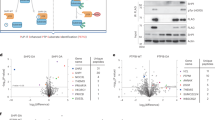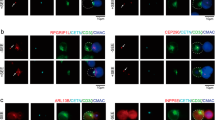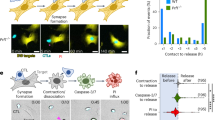Abstract
Here we investigated the involvement of HS1, the hematopoietic cell–specific homolog of cortactin, in the actin-based functions of natural killer cells. Involvement of HS1 in T cell regulation has been established, as HS1 is required for the formation of immune synapses. 'Knockdown' of HS1 in natural killer cells resulted in defective lysis of target cells, cell adhesion, chemotaxis and actin assembly at the lytic synapse. Phosphorylation of the tyrosine residue at position 397 (Tyr397) was required for adhesion to the integrin ligand ICAM-1 and for cytolysis, whereas phosphorylation of Tyr378 was required for chemotaxis. Phosphorylation of Tyr397 was also required for integrin signaling and recruitment of integrins, adaptors and actin to the lytic synapse. Thus, HS1 is essential for signaling and actin assembly in natural killer cells, and the functions of the two phosphorylated tyrosine residues are distinct and separable.
This is a preview of subscription content, access via your institution
Access options
Subscribe to this journal
Receive 12 print issues and online access
$209.00 per year
only $17.42 per issue
Buy this article
- Purchase on Springer Link
- Instant access to full article PDF
Prices may be subject to local taxes which are calculated during checkout








Similar content being viewed by others
Change history
18 September 2008
NOTE: In the version of this article initially published, some lanes in Figure 4a were cropped from the image. The error has been corrected in the HTML and PDF versions of the article.
References
Gomez, T.S. et al. HS1 functions as an essential actin-regulatory adaptor protein at the immune synapse. Immunity 24, 741–752 (2006).
Lanier, L.L. Natural killer cell receptor signaling. Curr. Opin. Immunol. 15, 308–314 (2003).
Allavena, P. et al. Molecules and structures involved in the adhesion of natural killer cells to vascular endothelium. J. Exp. Med. 173, 439–448 (1991).
Barber, D.F., Faure, M. & Long, E.O. LFA-1 contributes an early signal for NK cell cytotoxicity. J. Immunol. 173, 3653–3659 (2004).
Donskov, F., Basse, P.H. & Hokland, M. Expression and function of LFA-1 on A-NK and T-LAK cells: role in tumor target killing and migration into tumor tissue. Nat. Immun. 15, 134–146 (1996).
Bryceson, Y.T., March, M.E., Barber, D.F., Ljunggren, H.G. & Long, E.O. Cytolytic granule polarization and degranulation controlled by different receptors in resting NK cells. J. Exp. Med. 202, 1001–1012 (2005).
Constantin, G. et al. Chemokines trigger immediate β2 integrin affinity and mobility changes: differential regulation and roles in lymphocyte arrest under flow. Immunity 13, 759–769 (2000).
McLeod, S.J., Shum, A.J., Lee, R.L., Takei, F. & Gold, M.R. The Rap GTPases regulate integrin-mediated adhesion, cell spreading, actin polymerization, and Pyk2 tyrosine phosphorylation in B lymphocytes. J. Biol. Chem. 279, 12009–12019 (2004).
Shimonaka, M. et al. Rap1 translates chemokine signals to integrin activation, cell polarization, and motility across vascular endothelium under flow. J. Cell Biol. 161, 417–427 (2003).
Duchniewicz, M. et al. Rap1A-deficient T and B cells show impaired integrin-mediated cell adhesion. Mol. Cell. Biol. 26, 643–653 (2006).
Kolanus, W. et al. αLβ2 integrin/LFA-1 binding to ICAM-1 induced by cytohesin-1, a cytoplasmic regulatory molecule. Cell 86, 233–242 (1996).
Weber, K.S. et al. Cytohesin-1 is a dynamic regulator of distinct LFA-1 functions in leukocyte arrest and transmigration triggered by chemokines. Curr. Biol. 11, 1969–1974 (2001).
Upshaw, J.L. et al. NKG2D-mediated signaling requires a DAP10-bound Grb2-Vav1 intermediate and phosphatidylinositol-3-kinase in human natural killer cells. Nat. Immunol. 7, 524–532 (2006).
Billadeau, D.D., Mackie, S.M., Schoon, R.A. & Leibson, P.J. Specific subdomains of Vav differentially affect T cell and NK cell activation. J. Immunol. 164, 3971–3981 (2000).
Parham, P. Killer cell immunoglobulin-like receptor diversity: balancing signals in the natural killer cell response. Immunol. Lett. 92, 11–13 (2004).
Carpen, O., Virtanen, I., Lehto, V.P. & Saksela, E. Polarization of NK cell cytoskeleton upon conjugation with sensitive target cells. J. Immunol. 131, 2695–2698 (1983).
Standeven, L.J., Carlin, L.M., Borszcz, P., Davis, D.M. & Burshtyn, D.N. The actin cytoskeleton controls the efficiency of killer Ig-like receptor accumulation at inhibitory NK cell immune synapses. J. Immunol. 173, 5617–5625 (2004).
Krzewski, K., Chen, X., Orange, J.S. & Strominger, J.L. Formation of a WIP-, WASp-, actin-, and myosin IIA-containing multiprotein complex in activated NK cells and its alteration by KIR inhibitory signaling. J. Cell Biol. 173, 121–132 (2006).
Orange, J.S. et al. Wiskott-Aldrich syndrome protein is required for NK cell cytotoxicity and colocalizes with actin to NK cell-activating immunologic synapses. Proc. Natl. Acad. Sci. USA 99, 11351–11356 (2002).
Wu, H. & Parsons, J.T. Cortactin, an 80/85-kilodalton pp60src substrate, is a filamentous actin binding protein enriched at the cell cortex. J. Cell Biol. 120, 1417–1426 (1993).
Weaver, A.M. et al. Cortactin promotes and stabilizes Arp2/3-induced actin filament network formation. Curr. Biol. 11, 370–374 (2001).
Kitamura, D., Kaneko, H., Miyagoe, Y., Ariyasu, T. & Watanabe, T. Isolation and characterization of a novel human gene expressed specifically in cells of hematopoietic lineage. Nucleic Acids Res. 17, 9367–9379 (1989).
Uruno, T., Zhang, P., Liu, J., Hao, J.J. & Zhan, X. Haematopoietic lineage cell-specific protein 1 (HS1) promotes actin-related protein (Arp) 2/3 complex-mediated actin polymerization. Biochem. J. 371, 485–493 (2003).
Brunati, A.M. et al. Thrombin-induced tyrosine phosphorylation of HS1 in human platelets is sequentially catalyzed by Syk and Lyn tyrosine kinases and associated with the cellular migration of the protein. J. Biol. Chem. 280, 21029–21035 (2005).
Ruzzene, M., Brunati, A.M., Marin, O., Donella-Deana, A. & Pinna, L.A. SH2 domains mediate the sequential phosphorylation of HS1 protein by p72syk and Src-related protein tyrosine kinases. Biochemistry 35, 5327–5332 (1996).
Yamanashi, Y. et al. Identification of HS1 protein as a major substrate of protein-tyrosine kinase(s) upon B-cell antigen receptor-mediated signaling. Proc. Natl. Acad. Sci. USA 90, 3631–3635 (1993).
Taniuchi, I. et al. Antigen-receptor induced clonal expansion and deletion of lymphocytes are impaired in mice lacking HS1 protein, a substrate of the antigen-receptor-coupled tyrosine kinases. EMBO J. 14, 3664–3678 (1995).
Kahner, B.N. et al. Hematopoietic lineage cell specific protein 1 (HS1) is a functionally important signaling molecule in platelet activation. Blood 110, 2449–2456 (2007).
Cairo, C.W., Mirchev, R. & Golan, D.E. Cytoskeletal regulation couples LFA-1 conformational changes to receptor lateral mobility and clustering. Immunity 25, 297–308 (2006).
Green, C.E. et al. Dynamic shifts in LFA-1 affinity regulate neutrophil rolling, arrest, and transmigration on inflamed endothelium. Blood 107, 2101–2111 (2006).
Loubani, O. & Hoskin, D.W. Paclitaxel inhibits natural killer cell binding to target cells by down-regulating adhesion molecule expression. Anticancer Res. 25, 735–741 (2005).
Burridge, K. & Wennerberg, K. Rho and Rac take center stage. Cell 116, 167–179 (2004).
Djeu, J.Y., Jiang, K. & Wei, S. A view to a kill: signals triggering cytotoxicity. Clin. Cancer Res. 8, 636–640 (2002).
Woolf, E. et al. Lymph node chemokines promote sustained T lymphocyte motility without triggering stable integrin adhesiveness in the absence of shear forces. Nat. Immunol. 8, 1076–1085 (2007).
Li, Z. et al. Roles of PLC-β2 and -β3 and PI3Kγ in chemoattractant-mediated signal transduction. Science 287, 1046–1049 (2000).
Phee, H., Abraham, R.T. & Weiss, A. Dynamic recruitment of PAK1 to the immunological synapse is mediated by PIX independently of SLP-76 and Vav1. Nat. Immunol. 6, 608–617 (2005).
Maghazachi, A.A. Role of the heterotrimeric G proteins in stromal-derived factor-1α-induced natural killer cell chemotaxis and calcium mobilization. Biochem. Biophys. Res. Commun. 236, 270–274 (1997).
Haddad, E. et al. The interaction between Cdc42 and WASP is required for SDF-1-induced T-lymphocyte chemotaxis. Blood 97, 33–38 (2001).
Tehrani, S., Tomasevic, N., Weed, S., Sakowicz, R. & Cooper, J.A. Src phosphorylation of cortactin enhances actin assembly. Proc. Natl. Acad. Sci. USA 104, 11933–11938 (2007).
Luo, C. et al. CXCL12 induces tyrosine phosphorylation of cortactin, which plays a role in CXC chemokine receptor 4-mediated extracellular signal-regulated kinase activation and chemotaxis. J. Biol. Chem. 281, 30081–30093 (2006).
Hall, A. Rho GTPases and the control of cell behaviour. Biochem. Soc. Trans. 33, 891–895 (2005).
Khurana, D. & Leibson, P.J. Regulation of lymphocyte-mediated killing by GTP-binding proteins. J. Leukoc. Biol. 73, 333–338 (2003).
Ardouin, L. et al. Vav1 transduces TCR signals required for LFA-1 function and cell polarization at the immunological synapse. Eur. J. Immunol. 33, 790–797 (2003).
Billadeau, D.D. et al. The Vav-Rac1 pathway in cytotoxic lymphocytes regulates the generation of cell-mediated killing. J. Exp. Med. 188, 549–559 (1998).
Galandrini, R., Palmieri, G., Piccoli, M., Frati, L. & Santoni, A. Role for the Rac1 exchange factor Vav in the signaling pathways leading to NK cell cytotoxicity. J. Immunol. 162, 3148–3152 (1999).
Ballestrem, C., Wehrle-Haller, B. & Imhof, B.A. Actin dynamics in living mammalian cells. J. Cell Sci. 111, 1649–1658 (1998).
Radaeva, S., Sun, r., Jaruga., B., Nguyen, V., Tian, Z. & Gao, B. Natural killer cells ameliorate liver fibrosis by killing activated stellate cells in NKG2D-dependent and tumor necrosis factor-related apoptosis-inducing ligand dependent manners. Gastroenterology 130, 435–452 (2006).
Acknowledgements
NKL cells were a gift from M. Robertson (Indiana University School of Medicine); β2 integrin and Pyk2 were gifts from S. Blystone (State University of New York, Syracuse); Vav1 was a gift from V. Tybulewicz (National Institute for Medical Research, London); and the GFP-actin expression plasmid was provided by B. Imhof (University Medical Centre, Geneva). We thank the Siteman Cancer Center High Speed Sorter Core Facility, W. Eades and J. Hughes. Supported by the US National Institutes of Health (GM 38542 to J.A.C.), the National Institute of Allergy and Infectious Diseases (71429 to B.B.) and the US National Cancer Institute (P30 CA91842 to the Siteman Cancer Center High Speed Sorter Core Facility).
Author information
Authors and Affiliations
Corresponding author
Supplementary information
Supplementary Text and Figures
Supplementary Figures 1–2 and Methods (PDF 446 kb)
Supplementary Movie 1
Primary NK cells expressing GFP-HS1 in contact with K562 target cells. Frame interval 1 min. (MOV 315 kb)
Supplementary Movie 2
Primary NK cells expressing GFP-HS1 in contact with K562 target cells. Frame interval 1 min. (MOV 3501 kb)
Supplementary Movie 3
Adhesion of primary control NK cells on ICAM-1. Brightfield, frame interval 5 sec. (MOV 611 kb)
Supplementary Movie 4
Adhesion of primary control NK cells on Fn. Brightfield, frame interval 5 sec. (MOV 1837 kb)
Supplementary Movie 5
GFP-Actin dynamics in control NKL cells on ICAM-1. TIRF frame interval 3 sec. (MOV 2531 kb)
Supplementary Movie 6
GFP-HS1 dynamics in control NKL cells on ICAM-1. TIRF, frame interval 3 sec. (MOV 5063 kb)
Supplementary Movie 7
Adhesion of HS1 knockdown primary NK cells on ICAM-1 (MOV 1157 kb)
Adhesion of primary NK cells on Fn. Brightfield, frame interval 5 sec.
Supplementary Movie 8
Adhesion of HS1 knockdown primary NK cells on Fn. Brightfield, frame interval 5 sec. (MOV 1625 kb)
Supplementary Movie 9
GFP-Actin dynamics in HS1 knockdown NKL cells on ICAM-1. TIRF, frame interval 3 sec. (MOV 575 kb)
Supplementary Movie 10
Adhesion of HS1 knockdown primary NK cells expressing Y378F HS1 on ICAM-1. Brightfield, frame interval 5 sec. (MOV 1839 kb)
Supplementary Movie 11
GFP-Actin dynamics in HS1 knockdown NKL cells expressing Y378F HS1 on ICAM-1. Brightfield, frame interval 5 sec. (MOV 6879 kb)
Supplementary Movie 12
Adhesion of HS1 knockdown primary NK cells expressing Y397F HS1 on ICAM-1. Brightfield, frame interval 5 sec. (MOV 625 kb)
Supplementary Movie 13
GFP-Actin dynamics in HS1 knockdown NKL cells expressing Y397F HS1 on ICAM-1. TIRF, frame interval 3 sec. (MOV 210 kb)
Supplementary Movie 14
Chemotaxis of control primary NK cells on Fn. Brightfield, frame interval 1 min. (MOV 2762 kb)
Supplementary Movie 15
Chemotaxis of HS1 knockdown primary NK cells on Fn. Brightfield, frame interval 1 min. (MOV 5612 kb)
Supplementary Movie 16
Chemotaxis of HS1 knockdown primary NK cells expressing Y397F HS1on Fn. Brightfield, frame interval 1 min. (MOV 17924 kb)
Supplementary Movie 17
Chemotaxis of HS1 knockdown primary NK cells expressing Y378F HS1 on Fn. Brightfield, frame interval 1 min. (MOV 25323 kb)
Supplementary Movie 18
GFP-Actin dynamics during chemotaxis in control NKL cells on Fn. TIRF, frame interval 15 sec. (MOV 871 kb)
Supplementary Movie 19
GFP-Actin dynamics during chemotaxis in HS1 knockdown NKL cells on Fn. TIRF, frame interval 15 sec. (MOV 1353 kb)
Supplementary Movie 20
GFP-Actin dynamics during chemotaxis in HS1 knockdown NKL cells expressing Y397F HS1 on Fn. TIRF, frame interval 15 sec. (MOV 7111 kb)
Supplementary Movie 21
GFP-Actin dynamics during chemotaxis in HS1 knockdown NKL cells expressing Y378F HS1 on Fn. TIRF, frame interval 15 sec. (MOV 2049 kb)
Rights and permissions
About this article
Cite this article
Butler, B., Kastendieck, D. & Cooper, J. Differently phosphorylated forms of the cortactin homolog HS1 mediate distinct functions in natural killer cells. Nat Immunol 9, 887–897 (2008). https://doi.org/10.1038/ni.1630
Received:
Accepted:
Published:
Issue Date:
DOI: https://doi.org/10.1038/ni.1630
This article is cited by
-
Cysteine-rich intestinal protein 1 suppresses apoptosis and chemosensitivity to 5-fluorouracil in colorectal cancer through ubiquitin-mediated Fas degradation
Journal of Experimental & Clinical Cancer Research (2019)
-
Cell biological steps and checkpoints in accessing NK cell cytotoxicity
Immunology & Cell Biology (2014)
-
The role of HLA-G in immunity and hematopoiesis
Cellular and Molecular Life Sciences (2011)
-
Breaching multiple barriers: leukocyte motility through venular walls and the interstitium
Nature Reviews Molecular Cell Biology (2010)
-
Navigating Barriers: The Challenge of Directed Secretion at the Natural Killer Cell Lytic Immunological Synapse
Journal of Clinical Immunology (2010)



